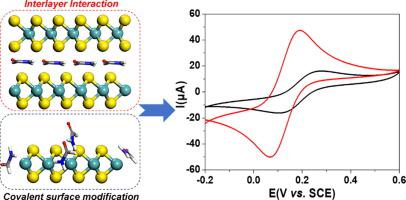Journal of Catalysis ( IF 7.3 ) Pub Date : 2020-09-17 , DOI: 10.1016/j.jcat.2020.09.009 Xiaorong Gan , Huimin Zhao , Dangyuan Lei , Peifang Wang

|
Liquid phase exfoliation (LPE) is a promising method for synthesizing two-dimensional (2D) 2H-MoS2 due to the balance obtained in the resulting yield and quality. Improvements in the electrocatalytic activity of 2D 2H-MoS2 are typically attributed to an increased number of active sites at the plane edges. However, the conclusion need be carefully redefined in the case of LPE, because the covalent surface modification and solvent intercalation between layers can affect the electrocatalytic activity as well. In this study, bulk 2H-MoS2 was exfoliated in three typical solvents, including N, N-dimethyl formamide (DMF), formamide, and 1-methyl-2-pyrrolidinone (NMP), to synthesize 2H-MoS2 nanosheets. X-ray diffraction (XRD), X-ray photoelectron spectroscopy (XPS), and Raman spectrum were used to confirm the possibility of surface and interface functionalization of the 2H-MoS2 nanosheets. Further, the effects on the electrocatalytic activity of 2H-MoS2 nanosheets were investigated mainly by density functional theory periodic calculations based on the analysis of electronic energy band structures. The results have demonstrated that 2H-MoS2 nanosheets prepared in formamide exhibit smaller average size and thickness, and higher electrocatalytic activity. The surface functionalization of the 2H-MoS2 nanosheets is indeed generated by Mo-N covalent bonds due to the presence of S vacancies. Such covalent functionalization leads to a slight decrease of energy band gap with 0.03 eV in a (3 × 3 × 1) 2H-MoS2 supercell. In contrast, the interface functionalization formed by the intercalation of solvent molecules (e.g., formamide) between layers can cause a remarkable decrease in the band gap of (1 × 1 × 2) 2H-MoS2, the phase transition from semiconductor to semimetal, higher carrier mobility, and smaller effective mass (me = 0.052 m0).
中文翻译:

液相剥落法提高2H-MoS 2纳米片的电催化活性:共价表面改性与层间相互作用
液相剥脱(LPE)是一种有希望的合成二维(2D)2H-MoS 2的方法,这是因为在获得的产率和质量上取得了平衡。2D 2H-MoS 2的电催化活性的提高通常归因于平面边缘处活性位点数量的增加。但是,在LPE的情况下,需要仔细重新定义结论,因为共价表面改性和层之间的溶剂插层也会影响电催化活性。在这项研究中,将本体2H-MoS 2在三种典型的溶剂中剥离,包括N,N-二甲基甲酰胺(DMF),甲酰胺和1-甲基-2-吡咯烷酮(NMP),以合成2H-MoS 2纳米片。使用X射线衍射(XRD),X射线光电子能谱(XPS)和拉曼光谱来确认2H-MoS 2纳米片表面和界面功能化的可能性。此外,主要通过基于电子能带结构分析的密度泛函理论周期计算,来研究对2H-MoS 2纳米片的电催化活性的影响。结果表明,以甲酰胺制备的2H-MoS 2纳米片表现出更小的平均尺寸和厚度,以及更高的电催化活性。2H-MoS 2的表面功能化由于存在S空位,Mo-N共价键确实产生了纳米片。这种共价官能化导致(3×3×1)2H-MoS 2超级电池中的能带隙略微减小,为0.03 eV 。相比之下,由层间溶剂分子(例如,甲酰胺)插层形成的界面功能化会导致(1×1×2)2H-MoS 2的带隙显着降低,即从半导体到半金属的相变,载流子迁移率更高,有效质量更小(m e = 0.052 m 0)。


























 京公网安备 11010802027423号
京公网安备 11010802027423号